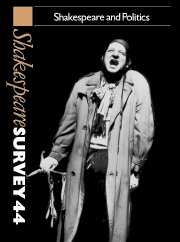Book contents
- Frontmatter
- Shakespeare and Politics
- Language, Politics, and Poverty in Shakespearian Drama
- Some Versions of Coup d’état, Rebellion and Revolution
- Woman, Language, and History in The Rape of Lucrece
- Love in Venice
- Two Kingdoms for Half-a-Crown
- ‘Fashion it thus’: Julius Caesar and the Politics of Theatrical Representation
- ’Demystifying the Mystery of State’: King Lear and the World Upside Down
- Tragedy, King Lear, and the Politics of the Heart
- The Politics of Shakespeare Production
- Shakespeare in the Trenches
- Shakespeare’s Earliest Editor, Ralph Crane
- Shakespeare’s Falconry
- Telling the Story of Shakespeare’s Playhouse World
- Shakespeare Performances in England, 1989–90
- Professional Shakespeare Productions in the British Isles January-December 1989
- Critical Studies
- Shakespeare’s Life, Times, and Stage
- Editions and Textual Studies
- Books Received
- Index
Love in Venice
Published online by Cambridge University Press: 28 March 2007
- Frontmatter
- Shakespeare and Politics
- Language, Politics, and Poverty in Shakespearian Drama
- Some Versions of Coup d’état, Rebellion and Revolution
- Woman, Language, and History in The Rape of Lucrece
- Love in Venice
- Two Kingdoms for Half-a-Crown
- ‘Fashion it thus’: Julius Caesar and the Politics of Theatrical Representation
- ’Demystifying the Mystery of State’: King Lear and the World Upside Down
- Tragedy, King Lear, and the Politics of the Heart
- The Politics of Shakespeare Production
- Shakespeare in the Trenches
- Shakespeare’s Earliest Editor, Ralph Crane
- Shakespeare’s Falconry
- Telling the Story of Shakespeare’s Playhouse World
- Shakespeare Performances in England, 1989–90
- Professional Shakespeare Productions in the British Isles January-December 1989
- Critical Studies
- Shakespeare’s Life, Times, and Stage
- Editions and Textual Studies
- Books Received
- Index
Summary
Love in Venice generally has a poor record. For Othello and Desdemona, as three centuries later for Merton Densher and Kate Croy, things work out badly. Love in Venice withholds happiness from Henri and Villanelle, the protagonists of Jeanette Winterson's novel, The Passion. It is fatal, of course, to Thomas Mann's Gustav Aschehbach. And Jessica, the twentieth-century heroine of Erica Jong's Serenissima, goes to Venice to play her namesake, and has the misfortune to fall in love with Shakespeare. Though the nature of their tragedies changes with cultural history, Venice is generally no place for lovers.
In the circumstances, this essay, which is about The Merchant of Venice, should perhaps have been called 'Love in Belmont'. Belmont, after all, is so evidently the location in the play of happy love. Belmont is a fairytale castle, where three suitors come for the hand of the princess, and undergo a test arranged by her father in order to distinguish between true love on the one hand and self-love and greed on the other. It is a refuge for eloping lovers, who flee the precarious world of capital and interest and trade, to find a haven of hospitality, music, poetry, old love stories retold in the night - and the infinite wealth (without origins) which makes all this possible. Belmont is the conventional critical other of Venice, its defining romantic opposite. Belmont, it is widely agreed, is feminine, lyrical, aristocratic - and vanishing ^ while Venice represents the new world of men, market forces and racial tensions.
- Type
- Chapter
- Information
- Shakespeare Survey , pp. 41 - 54Publisher: Cambridge University PressPrint publication year: 1991

